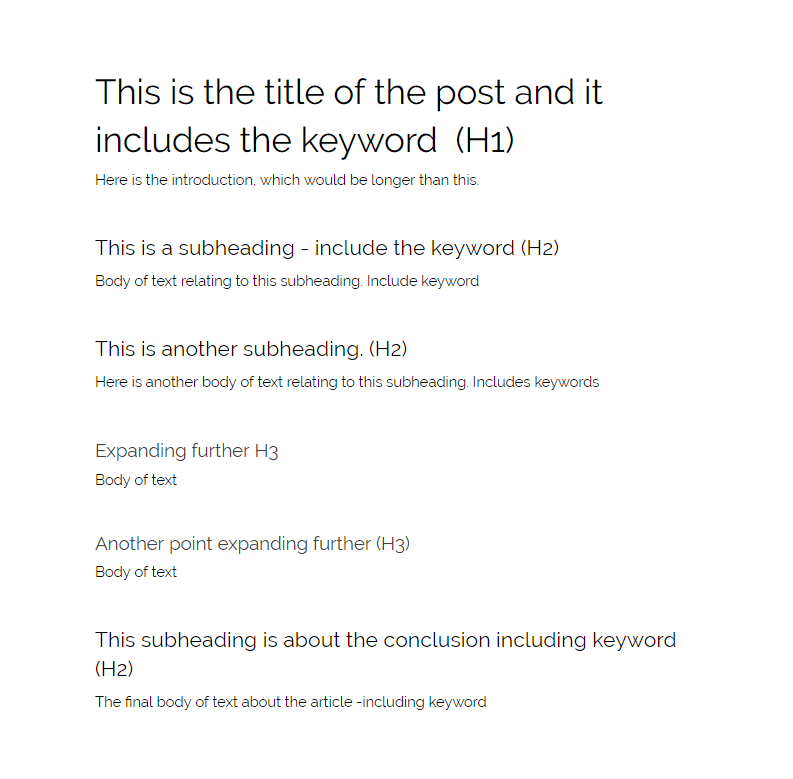
26 April 2022
How to write SEO friendly blogs that people actually like to read
Article Categories:
OK, I’m going to get real with you all.
You can write SEO friendly blogs that are also engaging for the reader. Despite what you may see on LinkedIn – the two are not mutually exclusive.
The good news is the key principles of writing badass copy, optimised for humans and search, are actually pretty simple.
You’ve got this!
Think before you write
Obvious? You’d think so! But I know loads of people who smash out articles and then try to pick the focus and retroactively stuff in keywords. That is a total pain in the ass. Would not recommend. 👎
You should use the keyword research you’ve already done (go you!) decide on a blog title and the focus keyword phrase. For example, the focus keyword for this article would be SEO friendly.
Also – a cool bit of info for you – a keyword doesn’t need to be just one word. It can be a whole phrase. 🤯This is why people are starting to use the term keyphrase instead.
A good title should be between 55-60 characters long, as this is what is displayed on search engine results pages (SERPS).
Your title should include your focus keyword, but it should also be exciting and engaging.
You want the reader to click on it, so you need to make this copy compelling. Get them excited and tease them with your content.
Work out the structure of the post
Next, we define the structure of the article, splitting it down into sections which will make it easier to write and for the reader to digest. Think of this as like creating chapters using all the important points you want to cover.
As with most writing, you want to have an introduction, the main body of copy, and a conclusion / call to action.
Creating a bullet point list of these can be really useful.
Using this SEO friendly article as an example:
- Introduction
- Think before you write
- Work out the structure of your post
- Use headings
- Add links
- Keywords
- Blog length
- Meta descriptions
- Images
- Conclusion
Now, we can work on writing copy to fit under each of these important points.
These also help you stay on track throughout your article – which is really useful if you have a tendency to go off-piste like me! 😂 I can occasionally get excited and go off in the wrong direction!
Use headings
Headings are the bomb! 💣💣💣
They help us break up the content and make it easier for the reader to digest. They’re also great for search engines too as they help them understand what the article is about.
Don’t know what your headings should be? Don’t worry – you’ve already written them! They are your bullet points from above!
Now for the technical side of using headings.
Headings are hierarchical.
There should only ever be 1 H1 on an article. This is the title.
Your bullet points from above should be H2.
If you decide to expand on any of these and break the content down further they should be H3.
H1 > H2 > H3

Add links
Links are ace. We 💜 links!
They help provide a more in-depth experience for your reader and help search engines understand more about your content. But please don’t go stuffing in links everywhere, only add them where it makes sense and adds value.
Pssst! Don’t forget to link internally to relevant pages and articles on your website. as well as linking externally to content on other websites that explain things in more detail and adds value.
You should use the relevant keywords as anchors. Don’t say “you can find the article here” – and use the word “here” as an anchor. That’s grim. 😂
Keywords
Not surprisingly, keywords are super important for an SEO friendly blog.
Use your focus keywords regularly throughout the post and headings where possible.
I recommend highlighting your focus keyword in your document so you can see how many times you have used it, before adding to your website.
Be careful not to overstuff your keywords, there is such thing as using them too many times! If you have the Yoast SEO plug in ( which I totally recommend) it will tell you if you have used your keyword too many times, or not enough times for the length of the article. Super handy!
Blog length
The age old question: how long should a blog be to be SEO friendly?
The answer, as with most SEO questions, is it depends Helpful, no?
It depends on what you’re writing and how much you have to say on the subject.
Search engines want your copy to be at least 300 words long.
However, having some articles on your site over 1500 words long can be really effective for SEO.
But try to keep the reader in mind. Have you covered everything you have to say on the subject and have reached 300 words. Then stop there.
Don’t waffle or drone on.
Keep your copy interesting and engaging.
Meta descriptions
Meta descriptions are a really important part of being SEO friendly. They need to be engaging and exciting. This is what shows up in SERPs, and we want the people reading it to be enticed enough to click through.
The meta description should be a summary of the article and what the reader will find out when they click through, and it must include your keyword.
Meta descriptions are usually around 160 characters. That may seem like a lot but you will probably struggle to be succinct and descriptive within that limit. I know I do! 😂
Images
Images, graphs, infographics, videos, and other media elements make blogs more engaging for the reader.
But they do need a bit of work to make them SEO friendly.
Make sure the file names reflect what the image is, including the keyword.
Don’t upload image files with file names like EP1026 – that doesn’t help the search engines know what the image is.
You also need to add Alt text describing the image when you upload them to your site. This is how search engines and people using screen readers know what the image is.
According to ability.net, there are almost 2 million people in the UK alone living with sight loss. That is a lot of people potentially using screen readers. We want them to have the best experience possible on your website. 💜
So there you have it. How to write articles that are SEO friendly and enjoyable for humans.
Oh and don’t forget to end every blog with a CTA (call to action).
What do you want people to do now they have read it?
Do you want them to share on social media?
Do you want them to contact you about your service?
Whatever it is – tell them. Add a fancy button – people love a fancy button.
Want to know more about writing SEO friendly blogs?
We LOVE to talk SEO.